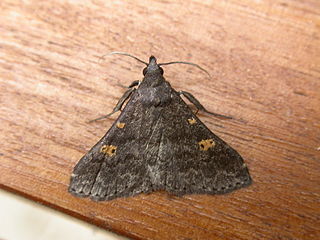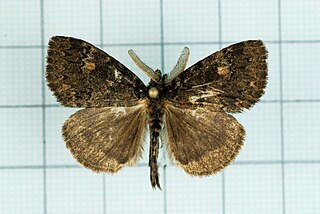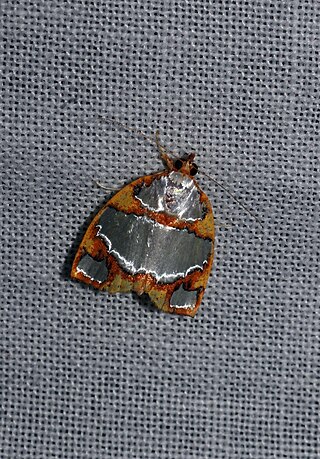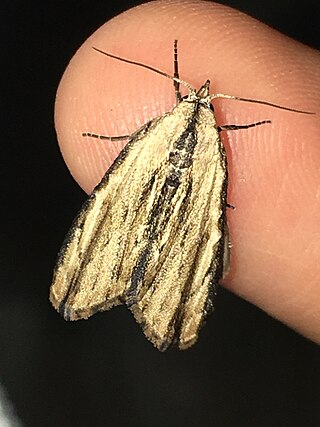
Cyana is a genus of moths in the family Erebidae. Species are well distributed in Africa, Madagascar, China, India, Sri Lanka, Myanmar, Sumatra, Java and Borneo. The genus was erected by Francis Walker in 1854.

Naarda is a large genus of erebid moths currently encompassing 108 species. Initially identified by Francis Walker in 1866, it is in the family Erebidae. Somewhat ruddy in appearance, this genus is distinguishable for its generally slender thorax and abdomen, and straight, porrect labial palpi. Most species are a light tan color, but shading can reach as deep as a charcoal, with muddy yellow, conspicuous reniform, orbicular stigmata featured on the forewings, sometimes reflected bilaterally superior.
Anigraea is a genus of moths of the family Euteliidae. The genus was erected by Francis Walker in 1862.

Anuga is a genus of moths of the family Euteliidae. The genus was erected by Achille Guenée in 1852.
Batracharta is a genus of moths of the family Erebidae. The genus was erected by Francis Walker in 1862.
Caedesa is a genus of moths of the family Euteliidae. The genus was erected by Francis Walker in 1862.
Savara is a genus of moths of the family Erebidae. The genus was erected by Francis Walker in 1862.

Ilema is a genus of tussock moths in the family Erebidae. The genus was described by Walker in 1855 and renamed by Moore in 1860, because Walker's chosen name was preoccupied.

Numenes is a genus of tussock moths in the family Erebidae. The genus was erected by Francis Walker in 1855.

Nygmia is a genus of tussock moths in the family Erebidae. The genus was erected by Jacob Hübner in 1820.

Ozola is a genus of moths in the family Geometridae first described by Francis Walker in 1861.

Titulcia is a genus of moths of the family Nolidae. The genus was erected by Francis Walker in 1864.

Zythos turbata is a moth of the family Geometridae first described by Francis Walker in 1862. It is found in southern Myanmar and on Borneo, Sumatra, Java, Peninsular Malaysia and the Philippines.

Risoba is a genus of moths of the family Nolidae erected by Frederic Moore in 1881.

Cyclosia is a genus of zygaenid moth that has a mimicry complex with the milkweed butterfly.

Cyclosia midamia is a moth in the family Zygaenidae. It is found in Malaysia and on Borneo. Five subspecies recognized.
Nyctemera latistriga is a moth of the family Erebidae first described by Francis Walker in 1854. It is found from the Oriental tropics of India, Sri Lanka, Myanmar, Andaman Islands, Sumatra, Borneo to the Philippines and Lombok.
Nygmia xanthomela is a moth of the family Erebidae first described by Francis Walker in 1862. It is found in Sri Lanka, Borneo, Java, Sumatra and Peninsular Malaysia.

Pompelon is a monotypic moth genus in the family Zygaenidae erected by Francis Walker in 1854. Its only species, Pompelon marginata, was first described by Félix Édouard Guérin-Méneville in 1843. It is a day-flying moth found throughout Southeast Asia, with sightings in the Philippines, Myanmar, Thailand, Sulawesi, Borneo, Peninsular Malaysia, Singapore, and Sumatra.

Sarbena is a genus of moths in the family Nolidae described by Francis Walker in 1862. They are found across Eastern, Southern, and South East Asia to the Solomon Islands. The caterpillars have white hairs and stack head capsules from past instars.













